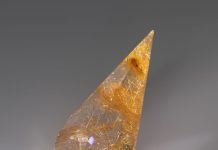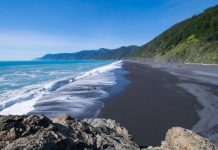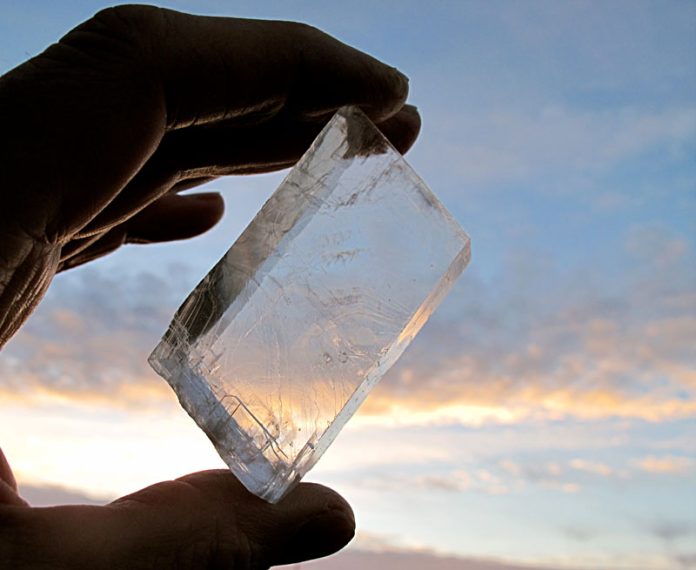
Iceland spar is a transparent variety of calcite that exhibits birefringence, the ability to polarize light and refract it in two slightly different directions. This creates double images when objects are viewed through Iceland spar crystals.
Calcite (calcium carbonate, CaCO3) crystallizes in the trigonal system and is slightly denser than quartz. Pure calcite is colorless, but impurities impart a range of soft colors. With its weak ionic bonding, calcite is rather soft (Mohs Scale of Hardness – 3.0) and cleaves easily into rhombohedrons.
Specimens of the Iceland spar variety of calcite are popular items in rock shops and at gem-and-mineral shows. Looking like miniature ice cubes, these colorless, transparent, cleaved rhombohedrons sell for only a few dollars each. But the commonplaceness of these little rhombohedrons belies a fascinating history that has had a profound impact on science and technology.
In Through the Looking-Glass, the sequel to Alice’s Adventures in Wonderland, author Lewis Carroll used the title phrase as a metaphor for peering into a world where nothing was quite what it seemed. When it came to understanding the mysterious nature of light, the “looking glass” for early scientists was optical calcite or Iceland spar.
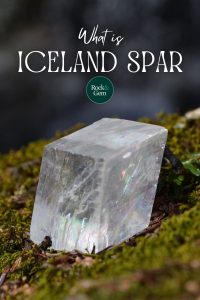
Sun Stone
Centuries before the magnetic compass was introduced to Europe, Viking mariners were demonstrating an uncanny ability to navigate the northern seas, even when cloudiness and fog obscured the sun or when the sun was below the horizon.
Icelandic monastery texts dating to 1250 mention a sólarsteinn (sun stone) that the Vikings used to determine the sun’s position without direct solar sightings. When a sunstone was held against the eye while scanning the horizon, polarized light cast two shadowy images upon the retina. The horizontal deflection at which their darkness equalized accurately indicated the position of the unseen sun.
Although archaeologists had previously found Iceland spar at various Viking cultural sites, they didn’t discover a direct indication of its navigational use until 2013 when Iceland spar was recovered in context with bronze navigational instruments on a sunken 1597 English warship. This discovery is thought to confirm the existence of the Vikings’ sunstone and also that its navigational use persisted long after the magnetic compass had appeared.
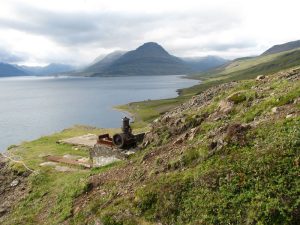
Helgustadir, Iceland
Iceland spar takes its name from Iceland where a Danish geological survey discovered transparent calcite crystals in 1667. This site, which later became the Helgustadir calcite mine, had likely been the source of the Vikings’ sunstone.
The first scientific description of Iceland spar, published in 1669, described a strange optical effect. Scientists already knew that all transparent crystals bent or refracted light, but the light that passed through Iceland spar emerged not as a single beam, but as two separate beams.
This optical phenomenon, known as birefringence, intrigued Europe’s leading scientists. In 1675, Dutch mathematician and physicist Christiaan Huygens discovered that two pieces of Iceland spar placed together did not produce four images as expected; instead, rotating one piece eliminated one of the two original images. Huygens’ observations led to the first theories that light consisted of waves or particles.
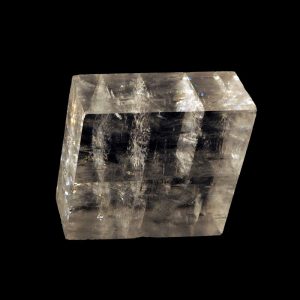
Nicol Prisms & “Magic Lanterns”
In 1828, Scottish physicist William Nicol cemented two pieces of Iceland spar together to invent the Nicol prism. The first piece split the incident light beam while the second absorbed one of the two beams. The remaining beam consisted of polarized light that vibrated in only a single plane.
Using this single-plane polarized light from Nicol prisms, scientists later developed such instruments as polarimeters, photometers, spectrophotometers, and polarizing microscopes that had—and continue to have—great scientific, industrial, and commercial value. In 1894, British physicist John C. Anderton created the first three-dimensional imaging using early “magic-lantern” projectors and Nicol prisms.
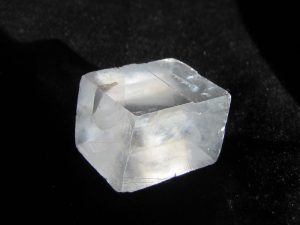
A Strategic Material
At the onset of World War II, American military forces were burdened with inferior optical bomb sights, anti-aircraft gun sights, and aerial gun sights; movement of the operator’s head, a frequent occurrence in combat, disrupted sight alignment with the target.
In 1942, researchers invented optical ring gun sights that employed thin, half-dollar-sized disks of Iceland spar to create concentric-circle sight pictures superimposed on targets. Because these circles appeared at optical infinity, head movement did not disrupt target alignment, thus greatly improving the accuracy of aerial and anti-aircraft gunnery.
Optical ring gun sights demanded defect-free, optical-grade Iceland spar crystals large enough to cut into specific sizes. But optical-grade Iceland spar was rare. And with German U-boats threatening Atlantic shipping, Iceland’s largely depleted Helgustadir mine was not a reliable source.
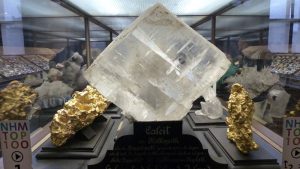
The Wartime Hunt for Iceland Spar
When Iceland spar was declared a strategic wartime material in 1942, the United States Geological Survey urgently began searching for sources and found small occurrences in Montana, California, New Mexico, and Sonora, Mexico. The Montana deposit produced 4,000 pounds of optical-grade Iceland spar, while the California deposit yielded 60,000 pounds—enough to manufacture 90,000 gun sights.
In Sonora, Mexico, the U.S. government paid farmers to search their fields where the calcite-vein-laced sedimentary rock had weathered into the soil. Regional farmers received $70,000 for six tons of crystals that yielded 150 pounds of optical-grade Iceland spar. Small amounts of optical-grade Iceland spar also came from a site in northern New Mexico.
While synthetic polarizing materials have now replaced Iceland spar in all technological uses, a few sites still provide specimens of these little rhombs that fill rock shop bargain trays and remind us of their fascinating history when Vikings and early scientists literally peered “through the looking-glass.”
This story about the Iceland spar previously appeared in Rock & Gem magazine. Click here to subscribe. Story by Steve Voynick. All photos courtesy Wikimedia Commons



